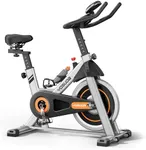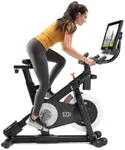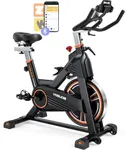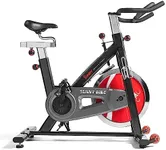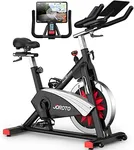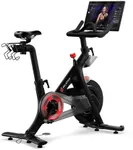Buying Guide for the Best Home Spin Bike
Choosing the right home spin bike can significantly enhance your fitness routine and ensure you get the most out of your workouts. When selecting a spin bike, it's important to consider several key specifications that will impact your comfort, performance, and overall experience. Understanding these specs will help you make an informed decision that aligns with your fitness goals and personal preferences.Flywheel WeightThe flywheel is the heavy wheel at the front of the bike that creates resistance as you pedal. A heavier flywheel provides a smoother and more stable ride, mimicking the feel of riding a real bike. Flywheels typically range from 14 to 40 pounds. For beginners or those looking for light to moderate workouts, a flywheel around 20 pounds may suffice. Intermediate users might prefer a flywheel between 20 to 30 pounds, while advanced users or those seeking intense workouts should consider a flywheel over 30 pounds.
Resistance TypeResistance on a spin bike can be adjusted to make pedaling easier or harder, simulating different terrains. There are two main types of resistance: friction and magnetic. Friction resistance uses brake pads to create resistance and is usually more affordable but can be noisier and require more maintenance. Magnetic resistance uses magnets to create resistance, offering a quieter and smoother ride with less maintenance. If you prefer a quieter and low-maintenance option, magnetic resistance is ideal. For those on a tighter budget, friction resistance can still provide a good workout.
AdjustabilityAdjustability refers to how much you can customize the bike to fit your body. This includes the ability to adjust the seat height, handlebar height, and the distance between the seat and handlebars. Proper adjustability ensures a comfortable and ergonomic riding position, reducing the risk of injury. If multiple people will be using the bike, or if you have specific ergonomic needs, look for a bike with a wide range of adjustability options.
Console FeaturesThe console on a spin bike can display various metrics such as speed, distance, time, calories burned, and heart rate. Some advanced consoles may also offer connectivity to fitness apps, virtual classes, or Bluetooth. Basic consoles are sufficient for tracking essential workout data, while more advanced consoles can enhance your workout experience with additional features and connectivity. Choose a console that matches your interest in tracking progress and integrating technology into your workouts.
Build Quality and StabilityThe build quality and stability of a spin bike are crucial for a safe and effective workout. A well-built bike will be sturdy, durable, and able to support your weight without wobbling. Look for bikes made from high-quality materials like steel and with a solid frame design. If you plan to use the bike frequently or for intense workouts, investing in a bike with superior build quality will ensure it lasts longer and provides a stable ride.
Pedal TypeSpin bikes come with different types of pedals, including standard pedals, toe cages, and clip-in pedals. Standard pedals are suitable for casual users, while toe cages provide more foot stability and are good for intermediate users. Clip-in pedals, which require special cycling shoes, offer the best foot stability and power transfer, making them ideal for advanced users or serious cyclists. Choose the pedal type based on your experience level and the type of workouts you plan to do.
